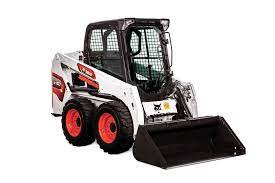Skid steers are incredibly versatile and highly manoeuvrable, but they can also be extremely dangerous. Proper precautions must be taken to prevent a serious injury or a fatality. Skid steer operators need to be aware of the hazards that they face and the hazards that they can cause for workers around them.
- Falls from working around leading edges
- Rollovers from instability and overloading
- Striking workers, pedestrians, or hidden obstacles
- Being struck by loader arms, attachments, or falling materials
- Slips and trips
- Exposure to fumes, noise, and vibration.
KNOW YOUR MACHINE
- Get the proper training and review the user manual before operating a skid steer.
- Perform regular inspections and document your findings.
- Check all high-pressure hydraulics for leaks.
- Find the rated operation capacity (ROC) for the machine and never exceed it. Overloading can make a skid steer excessively front-heavy. This can cause instability and reduce handling response.
- Never remove the rollover protective structure (ROPS) from a skid steer and keep side screens in place. People have been crushed to death when they were caught between the loader arms and the skid steer frame on unscreened machines.
- Always use the seat belt and/or the seat bar.
- When getting out of the machine, always turn it off first and lower the bucket or attachment.
- Always turn your machine off before changing attachments.
- Make sure any attachments you use are rated for your machine. Remember that an attachment will reduce your load capacity.
KNOW YOUR SURROUNDINGS
- Use barriers or another method to cordon off your work area. That way, you will not have to worry about hitting people in the area.
- If you must work near other people, make sure you know where the blind spots are on a skid steer. Make eye contact with anyone entering the work area and turn off the machine if you need to have a conversation.
- Never lift, swing, or otherwise move a load over anyone.
- Watch out for uneven floors or for objects buried in the ground. If the machine hits them, it may stop suddenly.
- If working on an elevated floor, make sure the floor can support the weight of the machine.
- If working on an elevated slab, ensure bumpers or barriers are installed in front of all openings.
- If working near a trench, always stay a safe distance from the edge.
KNOW THE SAFE OPERATING PROCEDURES
- Only worker's that are deemed competent of the use of a skid steer should operate one.
- Adjust your speed to suit the working conditions and terrain. Avoid sudden stops, starts, and turns.
- Review and follow the company's Safe Work Practice and Safe Job Procedure.
- Go around obstacles, not over or through them.
- Keep the bucket as low as possible when travelling or turning. A skid steer becomes less stable the higher you raise the loader arms.
- Never use a skid steer as a work platform or for carrying workers—it’s against the law.
- Never try to operate the steering levers or any other hydraulic controls while standing outside the cab. Because of the hydrostatic drive, the skid steer will respond instantly when the levers are engaged.
- Make sure that the attachment locking devices are engaged, even if you are switching attachments for only a few minutes. If an attachment is not locked, it could break free and roll back down the loader arms.
- Use hearing protection when operating it.


 CAD
CAD USD
USD